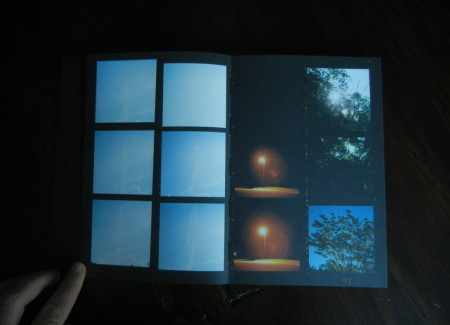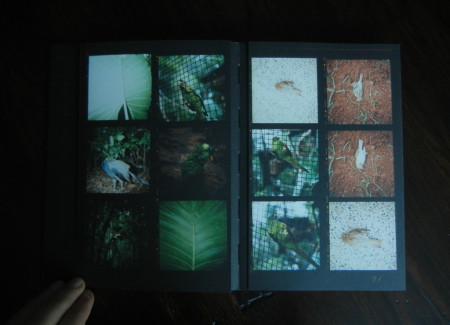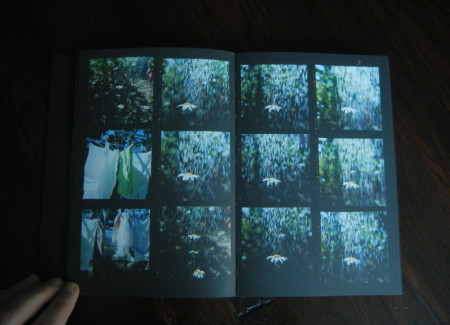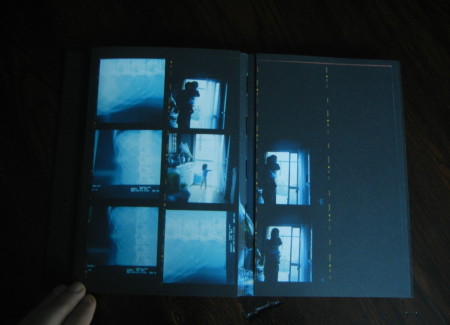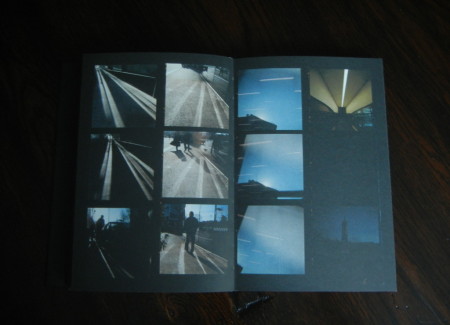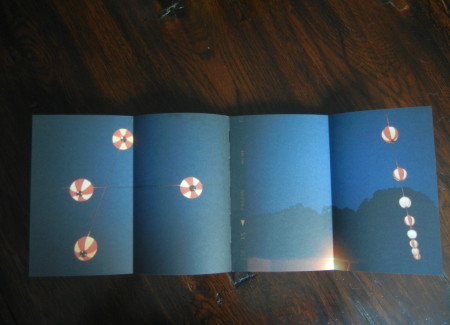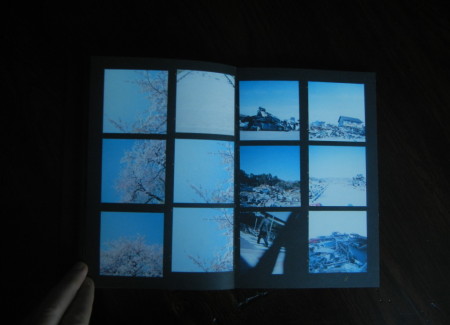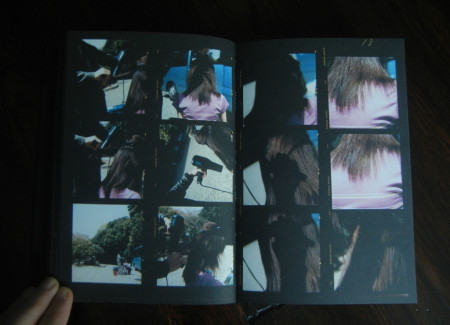JTF (just the facts): Published in 2013 by Kominek Books (here). Hardcover, 152 pages with 12 double page fold outs. The pages are arranged as contact sheets of 12 color images per two page spread; there are 50 spreads. 33 larger images (copies of images on the contact sheets) are found on the double page fold outs. There are no essays or texts. (Spread shots below.)
Comments/Context: Poring over a photographer’s contact sheets is a little like studying how his or her mind works. Instead of just seeing the perfect selection of final winners, we see the outtakes, the missteps, and the throwaways, the visual ideas that start one place and ultimately end up somewhere else. It reveals photography to be something much more than instantaneous random snapping – for many, it’s a deliberate process of refinement, and recalibration, and reconsideration, step by step, frame by individual frame, not unlike stalking or hunting or careful optimization.
This intimate volume of Rinko Kawauchi’s contact sheets doesn’t show us Kawauchi in her rawest form; these aren’t comprehensive work strips marked up with grease pencil x-outs, check marks, and circles, with obvious failures (overexposures, blurs, inadvertent goofs, end of the roll blackouts) mixed in. Instead, the filmstrips have been pared down and re-edited, using the contact sheet as its own kind of presentation form. We still see plenty of multiples and evolving imagery, but the process is much more controlled, and much of the messiness has been removed.
The reason this book is worth adding to your expanding library of Kawauchi books is that is shows the artist thinking in series. Aside from broader projects like the burning hills of Ametsuchi, we’re generally used to seeing Kawauchi work in single image form; while there may be patterns and rhythms to her imagery, and repeated cycles and subject matter that pop up again and again, for the most part, each photograph stands alone as an independent impression. What’s different here is that Kawauchi has taken those fleeting, ephemeral moments that are her signature and allowed them to expand into larger sequences.
Using the contact sheet look and feel (strips of images, sprocket holes, film edges, black background etc.) as a framework, she has created two types of groups. The first is a set of 12 images (both 6 image sets on an open spread) that follows a single narrative or impressionistic thread. Some are tiny cinematic stories: a haircut in a bus parking lot, her mother sewing in a hospital bed, meat being butchered, a meal being eaten, or baby chicks breaking out of their shells. Others are less like vignettes and more interested in slowly elapsing time, where the space in between the frames starts to have texture – the crashing of waves, a night of fireworks, kids playing at the playground, beads being added to a string. Still others take one repeated moment and let is blossom into something larger, with multiple perspectives and angles giving the instant breadth and depth – airplanes flying overhead, flickering candles in the dark, light pouring through translucent curtains, runners on the sidewalk.
In a second grouping of sheets, Kawauchi plays games with contrasts and pairings, taking two sets of imagery and connecting them together in the context of a single two page spread. Some turn on commonalities (the flare of a girl of a carousel with the flare on a pink rose, the shadowy ghost of an x-ray with the silhouette of a parent and child, a sea of colored balls with strings of party lanterns), while others highlight differences (a live parrot with a dead sparrow, drying laundry with rain drenching a daisy, cherry blossoms with the harrowing destruction of the tsunami). Perhaps the most poignant combination comes between images of her aging parents (some of her father in a hospital bed) placed together with a series of last light flared sunsets taken out of train windows. In all of these sheets, Kawauchi is making her visual patterns more explicit, elegantly connecting the dots between disparate elements.
Throughout the book, expandable double page folds add another layer to the contact sheet metaphor. Underneath many of the image arrays, an enlarged strip of two or three images unfolds, often cropped to show partial sections of several photographs. Sometimes this forces a turning of the book to see the pictures in the right orientation, and it always changes the scale of the viewing process – it’s like zooming in, away from the grid and into the closeness of the images. It’s a delicate, immediate photobook device that draws the viewer into a specific moment, bringing us back closer to the experience of a single image.
While some of these photographs will be familiar to many (the book draws from nearly a decade of Kawauchi’s work), there is a freshness to the presentation that gives this book its vitality. It shows Kawauchi thinking in progression, tying layers of her worldview together with cinematic grace. Seen in this way, the elemental wonder we’ve come to expect from her work is allowed to wander a bit, extending single moments into more complex, almost three dimensional thoughts.
Collector’s POV: Rinko Kawauchi is represented by Rose Gallery in Santa Monica (here). Her work has only recently begun to enter the secondary markets, and with only a few lots sold in various sizes, it’s hard to draw many meaningful pricing trends. As a result, gallery retail likely remains the best option for those collectors interested in following up.

